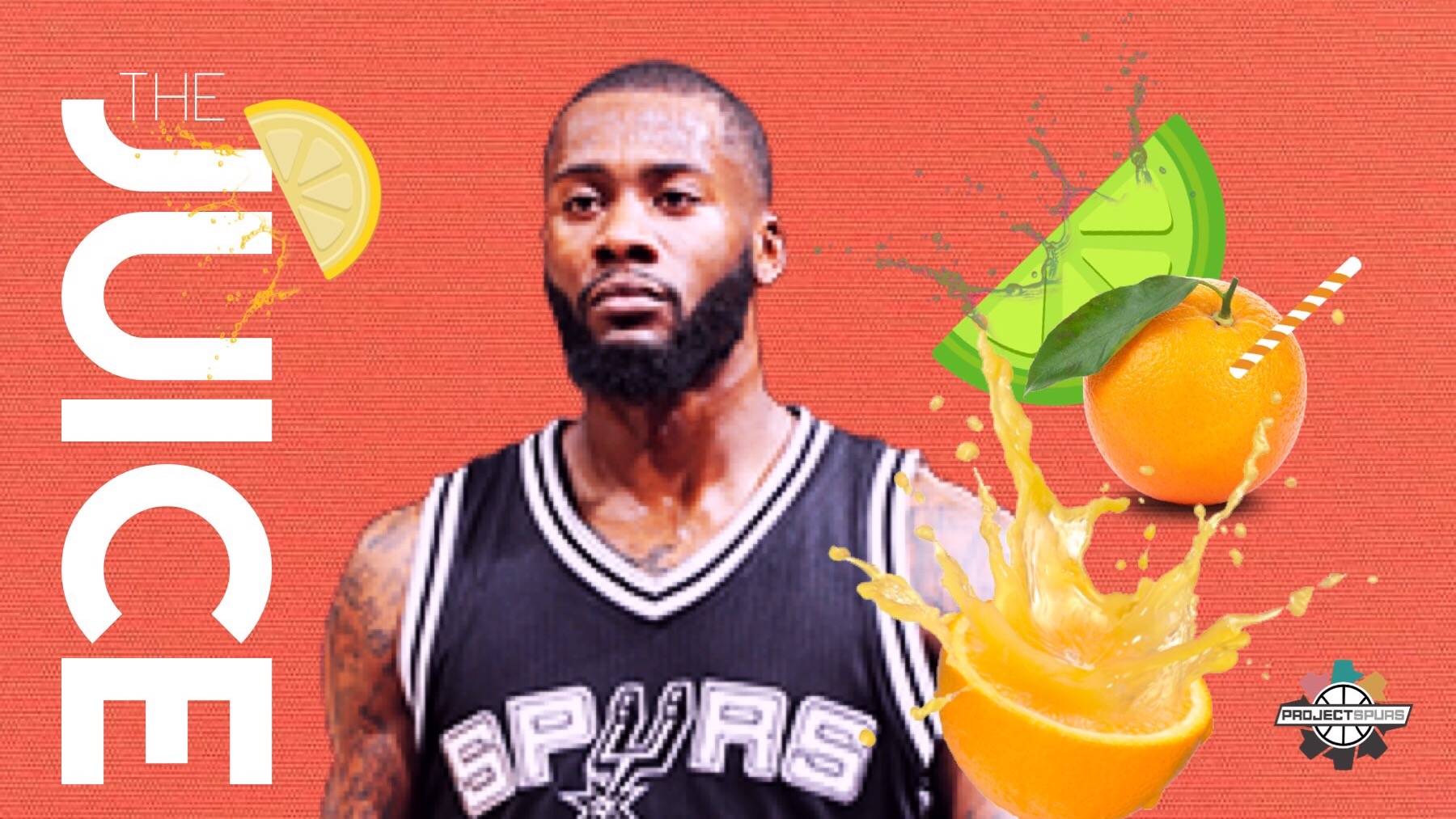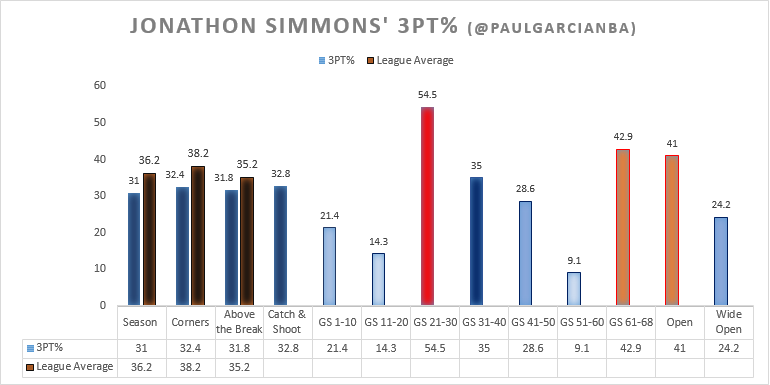In his second season with the San Antonio Spurs, 27-year old guard Jonathon ‘the Juice’ Simmons has carved a role for himself in the Spurs’ rotation, as he usually checks into games to give Kawhi Leonard a break, while he runs as the backup three with the Spurs’ second unit.
On a nightly basis, Simmons is the Spurs’ 7th playmaker with a usage percentage of 17.7% of the team’s possessions on offense. For his strengths, Simmons is a solid defender, capable of guarding 1s to 3s for limited stretches, as he has a Defensive Rating in holding opponents to 95.8 Points Per 100 Possessions when he’s on the floor. That’s a number better than the league best defense of the Spurs and Warriors as teams (101.0 PP/100). Simmons has put a highlight reel together this season when he displays his athleticism in his chase-down blocking ability. With more minutes and a consistent role, Simmons has gone from 5 blocks last season to 25 this season. He’s also increased his 24 steals last season to 43 this season. Overall, Simmons is a solid defender when Leonard needs a breather, and he’s also an option Spurs Head Coach Gregg Popovich can use against certain matchups in the event Leonard or Danny Green get into foul trouble.
On offense, Simmons’ strengths are attacking the rim and drawing free throws. Whether it’s in the open court, out of the pick and roll, or off dribble driving penetration, Simmons can play physical near the rim and either score, or draw free throws, as 45.6% of his points come from the paint, while 21.8% come from the free throw line. For playing 17.6 minutes per game, Simmons also contributes on the boards in grabbing 2.1 rebounds per game and he adds to the Spurs’ league best passing bench unit, as he tallies 1.6 assists per game.
Now that the positives of Simmons’ game have been laid out, it’s time to look at an area where he’ll be tested in the postseason, should he get meaningful minutes – his shooting. Whether it’s from the mid-range (33.3%), corner threes (32.4%), or above the break threes (31.8%), the data shows Simmons shoots below league average from all three of those areas on the floor. In the playoffs, when a team gets to play the other squad for a minimum of four games and maximum of seven games, it turns into a type of chess match, as both coaches will develop game plans to take away the other team’s strengths and make them try to beat them with their weaknesses.
When you think about Simmons, in the playoffs, opposing coaches will try to take away the rim from him, so he’s going to have to try to knock down outside shots if he wants to stay on the floor consistently for the Spurs. When you take apart Simmons’ data, you’ll see that some metrics show he might have a chance of knocking down 3-pointers when the shot is presented to him in certain scenarios.
Let’s look at the chart below from left to right. Beginning on the left is Simmons’ 3-point shooting percentage for the season, the league average 3PT%, Simmons’ Corner 3PT%, the league average Corner 3PT%, Simmons’ Above-the-break 3PT%, the league average Above-the-break 3PT%, Simmons’ catch-and-shoot 3PT%, then Simmons’ 3PT% in 10 game increments, and finally, Simmons’ 3PT% on open (defender 4-6 feet away) and wide open (defender over 6 free away) 3PT%.
As you can see, there’s a lot of cold (blue) areas for Simmons in some of the different areas tracked. However, there are some areas where Simmons has shown he can be a capable 3-point shooter. During that 21-30 game stretch where Simmons turned into a flame thrower, shooting 54.5% from three, he did that while making 6-of-11 threes per game. Simmons is currently shooting above league from three in his last eight games (42.9%), shooting 6-of-14 during that stretch.
The two key areas that project the types of threes Simmons might get in the playoffs are the open and wide open stats. 11.2% of Simmons’ threes come as ‘open’ shots, and he’s drilling 41.0% of them. If he can do this in a playoff series, then he should be ok in the minutes he receives. The ‘wide open’ threes are a problem, though, as defenses are abandoning him on 9.5% of those attempts, and he’s only shooting 24.2% on wide open looks. The Spurs will need Simmons to make those ‘wide open’ looks in situations where defenses double team Leonard or Aldridge, and the ball is swung to Simmons.
In the video below, I’ve broken down three possessions this season where Simmons has answered the call in stepping up and hitting some open corner threes. The possessions go from the pick-and-roll, to drive and kick, and finally to late in the shot clock.
[protected-iframe id=”0a4a68f422bf538429ea90161892b7f4-114320562-25928832″ info=”//screencast-o-matic.com/embed?sc=cbeOrf6J3i&v=5&ff=1″ width=”640″ height=”317″ frameborder=”0″ scrolling=”no”]In a playoff game, Simmons will mostly be responsible for having to hit open threes with less than 10 seconds left on the shot clock. On a given possession, he’ll usually move the ball around with his teammates, but once the shot clock starts winding down during those last 10 seconds, that’s where Simmons must shoot the three if open, whether from the corners, or above the break, as the video shows below.
[protected-iframe id=”d88fb026a7cdd05085594a695ffa15fb-114320562-25928832″ info=”//screencast-o-matic.com/embed?sc=cbeOr66J3F&v=5&ff=1″ width=”640″ height=”317″ frameborder=”0″ scrolling=”no”]Last season, Popovich played a 10-man rotation in the playoffs, with Kyle Anderson usually being the player who played the backup 3 behind Leonard whenever Leonard needed a break.
| Series | Kawhi Leonard (Mins) | Kyle Anderson (Mins) |
| Vs. Memphis | 31.5 mins | 17.0 mins |
| Vs. Oklahoma City | 37.5 mins | 10.2 mins |
With Simmons being the backup 3 this season, one can expect him to play those backup minutes this year behind Leonard in the playoffs, rather than Anderson. Will Simmons be able to make those corner threes late in the shot clock if he’s wide open? The answer for that question will ultimately be up to Simmons in the coming playoffs less than three weeks away.
Simmons will either become a restricted or unrestricted free agent this coming summer depending on whether the Spurs tender him the $1,671,382 qualifying offer to make him a restricted free agent. So, not only would productive performances in the playoffs help the Spurs’ success, but they could also add more value to Simmons’ free agency file on July 1.
Add The Sports Daily to your Google News Feed!

